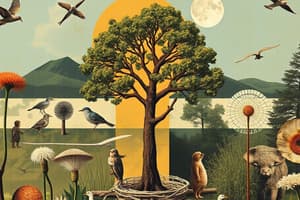Podcast
Questions and Answers
What is the smallest functional unit of life?
What is the smallest functional unit of life?
- Organ System
- Organ
- Cell (correct)
- Tissue
Which level of biological organization consists of multiple different species living together?
Which level of biological organization consists of multiple different species living together?
- Ecosystem
- Population
- Community (correct)
- Biosphere
Autotrophs are primarily characterized by their ability to:
Autotrophs are primarily characterized by their ability to:
- Convert nonorganic compounds into organic forms (correct)
- Form communities with other species
- Consume organic matter for energy
- Breed with other species
What term describes the interactions between different species?
What term describes the interactions between different species?
Which of the following defines a population?
Which of the following defines a population?
What defines an ecosystem?
What defines an ecosystem?
Which of the following accurately describes autotrophs?
Which of the following accurately describes autotrophs?
In which scenario would intraspecific interactions occur?
In which scenario would intraspecific interactions occur?
What level of biological organization is characterized by multiple different species living together in the same area and time?
What level of biological organization is characterized by multiple different species living together in the same area and time?
What are organ systems composed of?
What are organ systems composed of?
Flashcards
Species
Species
A group of organisms that can naturally breed to create fertile offspring.
Community
Community
Multiple different species living together in the same area and time.
Ecosystem
Ecosystem
A community and its abiotic factors in an environment.
Intraspecific
Intraspecific
Signup and view all the flashcards
Interspecific
Interspecific
Signup and view all the flashcards
What is a cell?
What is a cell?
Signup and view all the flashcards
What is a tissue?
What is a tissue?
Signup and view all the flashcards
What is an organ?
What is an organ?
Signup and view all the flashcards
What is a population?
What is a population?
Signup and view all the flashcards
What is a producer/autotroph?
What is a producer/autotroph?
Signup and view all the flashcards
Study Notes
Organization of the Biosphere
- The biosphere encompasses all parts of Earth where life exists, including all ecosystems.
- An ecosystem combines a community of organisms and its non-living (abiotic) environment.
- A community is a group of different species living in the same area and time.
- A population is a group of the same species inhabiting the same area during the same time period.
- A species is a group of organisms that can naturally breed and produce fertile offspring.
- An individual organism is a single member of a species.
- Organ systems are groups of organs working together for specific life functions.
- An organ is a collection of tissues with a shared function.
- Tissue is made of similar cells performing related tasks.
- Cells are the fundamental functional units of life.
Autotrophs/Producers
- Autotrophs obtain energy from light (phototrophs) or non-organic sources (chemotrophs).
- They convert non-organic substances into organic forms.
- They are the first trophic level, supporting all other life.
Interactions
- Intraspecific interactions involve members of the same species.
- Interspecific interactions involve two or more different species.
Studying That Suits You
Use AI to generate personalized quizzes and flashcards to suit your learning preferences.




